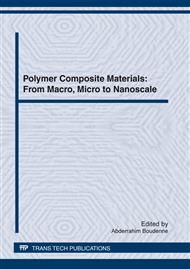[1]
R. Kotsilkova: Thermoset Nanocomposites for Engineering Applications (Smithers Rapra Press, August 2007).
Google Scholar
[2]
C. Zilg, R. Mulhaupt, J. Finter: Macromol. Chem. Phys. Vol. 200, 661-670 (1999).
Google Scholar
[3]
A. Zerda, A. Lesser: Journal of Polymer Science Vol. 39, 1137-1146 (2001).
Google Scholar
[4]
X. Kornmann, R. Thomann, R. Mulhaupt, J. Finter, L. Berglund: Journal of Applied Polymer Science Vol. 86, 2643-2652 (2002).
Google Scholar
[5]
K. Wang, L. Chen, J. Wu, M.L. Toh, C. He, and A.F. Yee: Macromolecules Vol. 38, 788-800 (2005).
Google Scholar
[6]
B. Qi, Q.X. Zhang, M. Bannister, Y.W. Mai: Composite Structures Vol. 75, 514-519 (2006).
Google Scholar
[7]
A.J. Kinloch, A.C. Taylor: Journal of Material Science Vol. 41, 3271-3297 (2006).
Google Scholar
[8]
S.R. Lim, and W.S. Chow: Polymer-Plastics Technology and Engineering Vol. 50, 182-189 (2011).
Google Scholar
[9]
T.P. Mohan, K. Kanny, R. Velmurugan: Int J Plast Technol Vol. 13, 123-132 (2009).
Google Scholar
[10]
T.D. Ngo, M.T. Ton-That, S.V. Hoa, K.C. Cole: Journal of Science and Engineering of Composites Materials Vol. 17, (2010).
Google Scholar
[11]
B. Akbari, R. Bagheri: European Polymer Journal Vol. 43, 782-788 (2007).
Google Scholar
[12]
G. Khanbabaei, J. Aalaie, A. Rahmatpour, A. Khoshniyat, and M.A. Gharabadian: Journal of Macromolecular Science Vol. 46, 975-986 (2007).
DOI: 10.1080/00222340701457287
Google Scholar
[13]
J.Y. Park, T.B. Davis, and P.L. Sullivan: Journal of Reinforced Plastics and Composites Vol. 29, (2010).
Google Scholar
[14]
I. Zaman, Q.H. Le, H.C. Kuan, N. Kawashima, L. Luong, A. Gerson, J. Ma: Polymer Vol. 52, 497-504 (2011).
DOI: 10.1016/j.polymer.2010.12.007
Google Scholar
[15]
Q. Zhao, S.V. Hoa: Journal of Composite Materials Vol. 41, 497-504 (2007).
Google Scholar
[16]
J. Chia, K. Hbaieb, and Q.X. Wang: Key Engineering Materials Vols. 334-335, 785-788 (2007).
DOI: 10.4028/www.scientific.net/kem.334-335.785
Google Scholar
[17]
J.Y.H. Chia, in: Finite Element Modelling Clay Nanocomposites and Interface Effects on Mechanical Properties (IUTAM Bookseries, Vol. 13, 241-248, 2009).
DOI: 10.1007/978-1-4020-9557-3_25
Google Scholar
[18]
M.J. Stevens: Macromolecules Vol. 34, 2710-2718 (2001).
Google Scholar
[19]
M.L. Chan, K.T. Lau, T.T. Wong, in: Interfacial Bonding and Mechanism in Nanoclay/Epoxy Composite. Proc. ICCE-17, (2009).
Google Scholar
[20]
A.K. Helmy, E.A. Ferreiro, and S.G. deBussetti: Journal of Colloid and Interface Science Vol. 268, 263-265 (2003).
Google Scholar
[21]
Y.T. Fu, H. Heinz: Chem. Mater Vol. 22, 1595-1605 (2009).
Google Scholar
[22]
Ł. Figiel, C.P. Buckley: Computational Materials Science Vol. 44, 1332-1343 (2009).
Google Scholar
[23]
A. Dorigato, S. Morandi, A. Pegoretti: Journal of Composite Materials, in press.
Google Scholar


